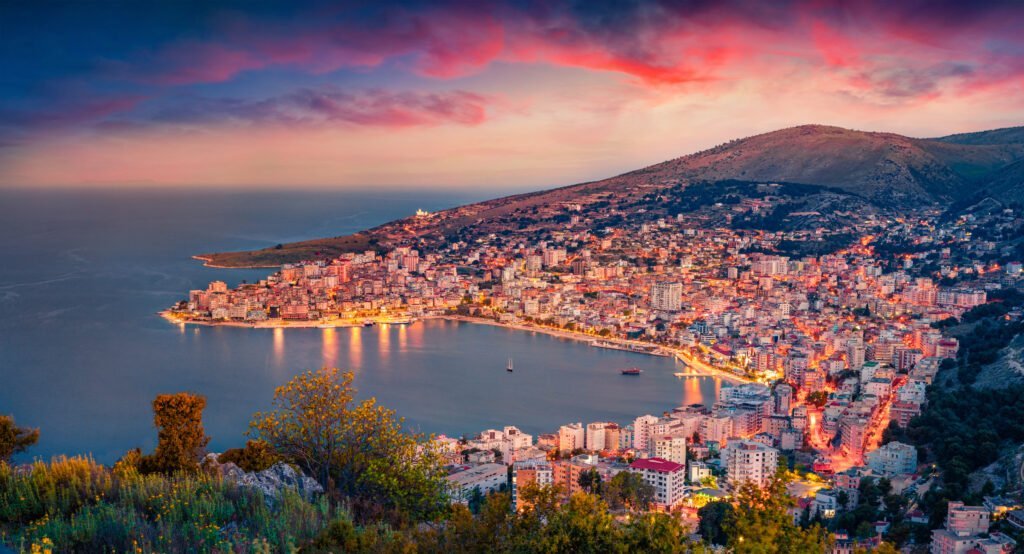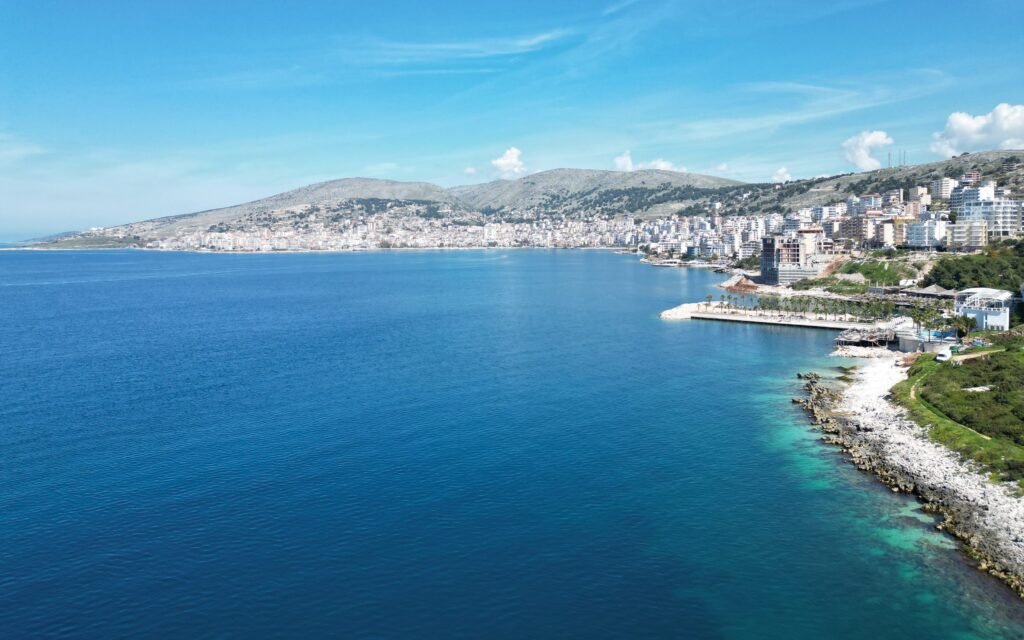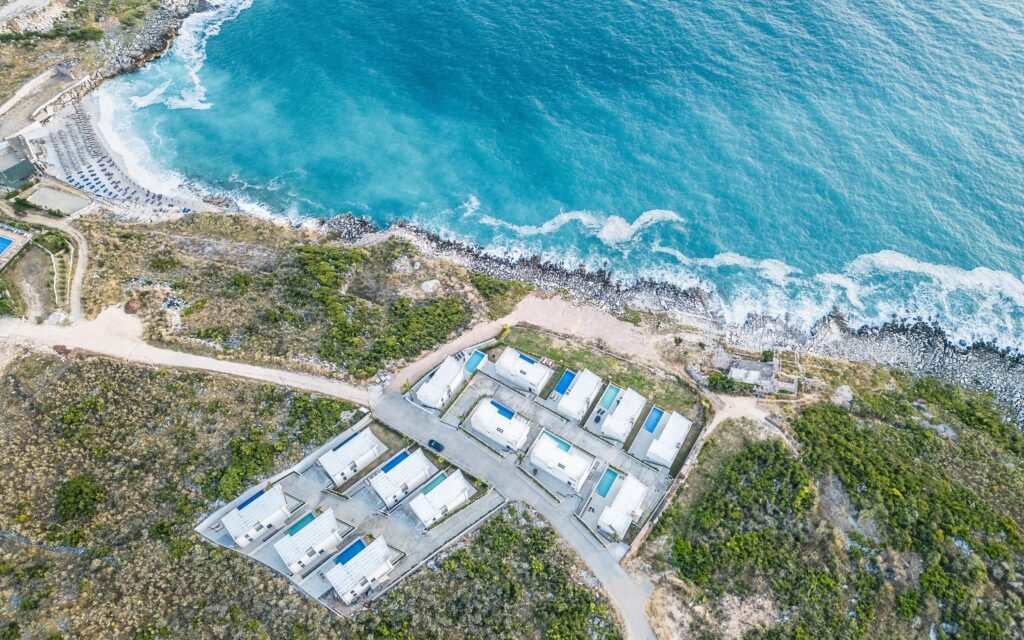Saranda, the charming city in the heart of the Albanian Riviera, has been a subject of intrigue for many, evoking questions beyond the mere count of its population. Yet, precisely this query – “how many people live in Saranda?” – takes us on a fascinating journey, uncovering aspects of history, culture, economy, and urban planning that breathe life into this stunning coastal city.

A Population in Flux
According to the latest data gathered in 2023, Saranda, the gem of the Albanian Riviera, boasts an official resident count of approximately 35,000 individuals. This number, however, is not a static one. It is much like the city’s pulse, rhythmically changing with the seasons and various socio-economic factors.
One of the most prominent influences on the population dynamics of Saranda is seasonal variation. During the quieter, cooler months, the city houses its local inhabitants who partake in everyday life, from tradesmen selling goods in the marketplace to children filling the schools. Yet, as the temperature starts to climb, so does Saranda’s populace. It is during these warm, sun-drenched months that the city’s character undergoes a vibrant transformation.
In the bustling summer season, Saranda’s numbers see a marked increase, as both Albanians from different parts of the country and international tourists flock to the city to bask in its Mediterranean charm. The allure of the turquoise Ionian Sea, the sun-kissed beaches, and the city’s vibrant nightlife makes it a desirable retreat from the mundanity of routine life. This influx often passes the city’s standard population, soaring to an estimated 300,000 people during the peak season.
A Vibrant History Reflected in Population Growth
Understanding the population trends of Saranda is akin to embarking on a historical journey through the ages, each epoch imprinting its mark on the city’s demographic structure. Nestled in the southernmost tip of Albania, Saranda’s rich history spans back to ancient times. Its name, Saranda, is rooted in religious folklore, stemming from an early Christian monastery titled ‘Agioi Saranta,’ which translates to the ‘Forty Saints.’
Saranda’s history is intricately interwoven with its geographical and strategic placement. During the Ottoman rule, Saranda was a quiet, unassuming fishing village. Its population was modest, mainly comprising fisherfolk and their families who eked out a living from the bounty of the Ionian Sea. These communities were closely-knit, where generations grew up together, and the population saw only gradual growth over centuries.
However, the winds of change began to blow over Saranda in the 20th century, following the end of World War II. The installation of the communist regime marked a radical shift in the city’s trajectory. Saranda, like many other Albanian cities, experienced an era of industrial development under communist rule. The city began to expand beyond its original borders, with new industries bringing in workers and their families from across the country. Consequently, the city’s population increased, albeit modestly when compared to larger Albanian cities like Tirana or Durrës.
The fall of the Albanian communist regime in the 1990s proved to be a pivotal moment in Saranda’s history. As the country’s economy stumbled and job opportunities dwindled, a significant portion of the city’s population chose emigration in search of better prospects. This mass exodus led to a dip in Saranda’s population and left the city in a period of demographic stagnation.
However, as the dawn of the new millennium arrived, Saranda embarked on a journey of revival. The city, with its picturesque coastline and historical marvels, began to harness its untapped potential as a tourist hotspot. Slowly but surely, the city started attracting tourists from across Albania and beyond, leading to a resurgence in local businesses, hospitality services, and infrastructure development. This shift resulted in a steady and sustained increase in Saranda’s population, as the city became an attractive place to live, work, and visit.

The Seasonal Dance of Saranda Population
This seasonal swell of tourists leaves an indelible imprint on Saranda’s infrastructure and economy. As thousands throng the city’s attractions, businesses flourish. The hospitality sector, especially, experiences a boom, with hotels, restaurants, and local businesses witnessing a surge in demand.
In response to this demand, Saranda has taken substantial strides in urban planning and infrastructure development. Efforts are in place to improve transportation systems, expand accommodation options, and enhance public spaces to cater to the seasonal population increase. These changes not only benefit the city’s visitors but also significantly enhance the overall quality of life for Saranda’s permanent residents.
The revenue generated from tourism fuels these infrastructural developments. With every visitor contributing to the city’s economy, Saranda has witnessed the growth of improved public services, better healthcare facilities, and advanced educational institutions. The city’s urban landscape has transformed, with new construction projects blending seamlessly with preserved historical structures.
With the city’s resources stretched during peak tourist season, sustainable and effective management becomes crucial. From waste management to water supply, maintaining public utilities for a population that doubles in a few months is a significant task. Yet, Saranda’s resilience shines through as the city constantly evolves and adapts, seeking to balance the demands of tourism with the needs of its residents.

Big Influence and Future Prospects of Saranda
A close examination of Saranda’s demographic landscape reveals an intriguing trend – the rise in expatriate populations. Predominantly from Western European countries, these expats are lured by the city’s myriad attractions. From the relatively affordable cost of living to the vibrant local culture and the mesmerizing natural landscapes, Saranda offers an irresistible blend of simplicity and charm that has enticed many to call it their second home.
This expatriate community has brought a fresh dimension to Saranda’s multicultural ethos. It is not uncommon to hear German, French, or English conversations in the city’s cafés, offering an authentic global experience within this Mediterranean city. These diverse cultural interactions have enriched the city, leading to the emergence of a harmonious blend of Albanian tradition with international influences.
Saranda’s strategic geographical position, snugly placed at the Ionian Sea’s edge, adjacent to the Greek island of Corfu, further molds its demographic composition. The proximity to Greece, both in terms of geography and historical ties, facilitates smooth mobility, leading to a significant Greek influence on the city’s culture and population.
As we gaze into the future, Saranda’s population trajectory looks promising. The upward trend, buoyed by a burgeoning tourist industry and the ever-growing expatriate community, shows no signs of abating. Projections suggest a steady climb in the population figures, painting a picture of a thriving and dynamic Saranda. Learn more here.


